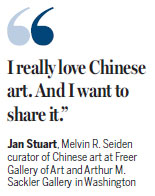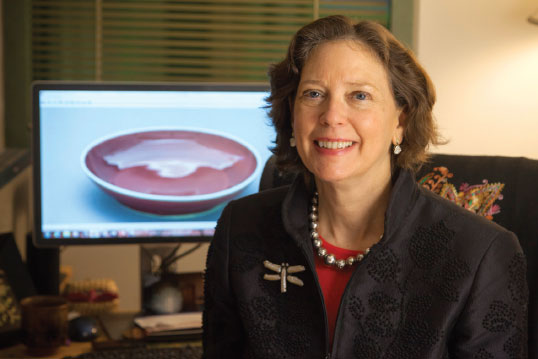Jan Stuart: curator tells stories of creativity of Chinese art
|
Jan Stuart, the Melvin R. Seiden curator of Chinese art at the Freer Gallery of Art and Arthur M. Sackler Gallery, in her office in March with a picture of a copper-red glazed dish from the Xuande period, which is in the exhibition Red: Ming Dynasty/Mark Rothko. Provided To China Daily |
Jan Stuart has a twinkle in her eye every time she talks about Chinese art.
"China is fantastic," Stuart said at a Brookings Institution panel on Chinese contemporary art in August, "because it has the largest breadth of creativity and artists working with different responses."
Born in New York City and raised in Connecticut, Stuart - Melvin R. Seiden curator of Chinese art at the Freer Gallery of Art and Arthur M. Sackler Gallery in Washington - has a life story tied closely with China, starting from a young age.
She recalled having a Chinese boy in her third-grade class who was made fun of by other boys for being different. Her teacher then asked the class, pointing at a book: "Where was paper invented?"
"We all said, 'USA!' And she goes, 'China,'" Stuart said with a smile. "Then she asked, 'Where was printing invented?' All the students said, 'USA!' And she said, 'China.' At the end she goes, 'Now children, is there anyone in this room who wants to make fun of a boy because he's from China?'"
"So right then and there I realized, China is a very special place," Stuart said.

Stuart earned her Bachelor of Arts and master's in East Asian studies from Yale University and a second master's degree from Princeton University in Chinese art and archeology. She has worked at the Freer and Sackler Galleries for more than 20 years.
"I really love Chinese art," Stuart said as she discussed the most rewarding part of being a Chinese art curator. "And I want to share it."
Stuart brings more attention to the different fields of the art, including Buddhist sculpture, ceramics and decorative arts.
Her fluent Mandarin knowledge made her a better storyteller. She took Chinese classes in college and stayed nine months in Taipei to study the Chinese language.
"I never would have so many wonderful conversations with scholars about Chinese art and archeology if I couldn't speak the language," Stuart said. "Knowing the language opens you up to a different way of thinking."
She sees museum work as "diplomacy", saying one of the advantages as an American curator of Chinese art is being "more sensitive to knowing what an average American doesn't know".
"A Caucasian American will find a Chinese ancestor portrait hanging in the dining room without knowing why or how these paintings were created," said Stuart. "That's where you come up with some ways to interpret for the objects, and tell a story that gets other people excited about a new culture."
Stuart has been seeking ways to bring a new audience into the galleries that they don't usually visit.
She found similarities in two objects created more than five centuries apart, a Chinese imperial porcelain dish and a painting by Mark Rothko, and decided to put them together on exhibition.
"Sometimes you need to give the audience a chance to think," Stuart said. "Well, if they love Rothko's colors, actually, they might love the imperial Chinese dish.
"People tend to go to what's familiar with them," she said. "For people who know nothing about China, (the Western vocabularies in Chinese art) are what they can see and understand.
"We should make sure that we always have Chinese art on view and put. more indifferent kinds of Chinese art in museums and gallery shows," said Stuart. "That's what we do, and that's all I can do, to put art on view."
Stuart gets fulfillment as a curator when she sees nose prints and fingerprints on the glass cases in an exhibition.
"You want a lot of people to go," she said. "You look for evidence that they are looking closely."
Stuart mentioned an idea to collaborate with the Beijing Palace Museum and the Massachusetts Peabody Essex Museum on an exhibition about Chinese empresses of the last dynasty, and open it to public in 2019, which is the 40th anniversary of the normalization of US-China relations.
"They are exhibitions that have nothing to do with politics as the subject," said Stuart. "It's just a perfect occasion to celebrate and to show that as two cultures, we are still happy together to learn about each other."
Having been in China in the early 1980s, Stuart has seen vast changes in the past 30 years.
"So many things are happening so fast," said Stuart, amazed while also concerned about China's rapid development.
Stuart values the energy and creativity in China.
"It's such a rich, strong nation that foreigners can be very easily attracted to the depth of Chinese culture," Stuart said. She believes Chinese art will show its strength by inviting and embracing the world.
"China has given us a lot of the best artists the world has today," said Stuart. "It's just going to keep going up, because of the great creativity."
Li Shuhan in Washington contributed to this story.










